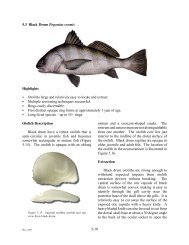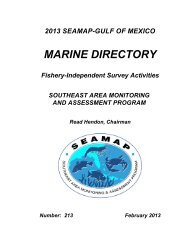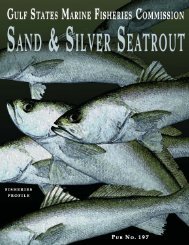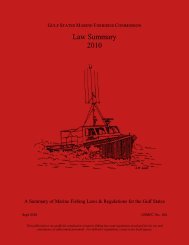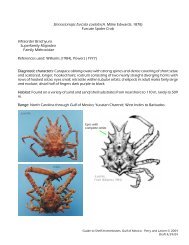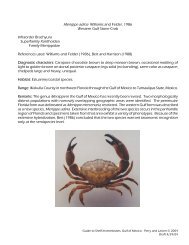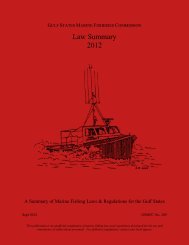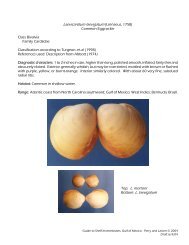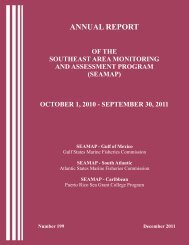Guidelines for Marine Artificial Reef Materials, Second Edition
Guidelines for Marine Artificial Reef Materials, Second Edition
Guidelines for Marine Artificial Reef Materials, Second Edition
You also want an ePaper? Increase the reach of your titles
YUMPU automatically turns print PDFs into web optimized ePapers that Google loves.
During Hurricane Gordon (August 1994), a 600 foot long vessel loaded with concrete and sunk off<br />
Bimini, Bahamas in 80 to 100 feet water was moved several hundred feet shoreward and plowed<br />
across live bottom (Todd Barber, personal communication). The M/V Antares, a 387 foot coastal<br />
freighter which was sunk intact on its port side in 125 feet of water off Pensacola, Florida on<br />
September 27, 1995, was subjected to the category 3 <strong>for</strong>ces of Hurricane Opal, on October 4, 1995.<br />
The stern and bow sections of the ship separated from the center portion, where cargo holds also<br />
sustained damage. The pieces remain on site and continue to attract fish, but the damaged vessel<br />
is now somewhat disorienting to divers (Tom Maher, personal communication).<br />
Smaller vessels such as tugs that are affected by major storm events are most frequently impacted<br />
by the loss or damage of the wheelhouse or superstructure while the hull remains intact.<br />
Superstructures with wooden siding or roofs or that had add-on extensions or components reattached<br />
to the original structure appear to be more vulnerable to damage (Jon Dodrill, personal<br />
communication). One of the oldest tugs in the Florida reef system, a tug, the Paul Main, deployed<br />
off Jacksonville, FL in 70 feet of water in 1968 still remains a popular dive site in 2003 though its<br />
superstructure has been torn away.<br />
Some vessels, not operationally designed to withstand heavy sea conditions, and further weakened<br />
through age and deterioration, if deployed as artificial reefs, may not withstand normal sea/current<br />
conditions, let alone a major storm event. As an example, a triple deck 340 foot, 60 year old car<br />
ferry whose lower deck sat under water <strong>for</strong> 12 years prior to salvage was sunk in a .75-1.5 knot<br />
current environment off Palm Beach County, Florida in 110 feet of water May 23, 1993 at a cost<br />
of $55,000. Following the arrival of the first winter weather seven months later, the lowest deck had<br />
collapsed, and the upper two decks had been wrenched sideways, resulting in the creation of jagged<br />
sheets of metal and other hanging debris, and <strong>for</strong>ming a potential diving hazard Salvage procedures,<br />
use of explosives, and impact of the vessel with hard bottom upon sinking, may also have<br />
contributed to the ship’s initial deterioration (Jim Vaughn, personal communication). Continued<br />
monitoring of the vessel showed that the superstructure was eventually completely sheared off and<br />
lies on the seabed west of the vessel. Nine years after sinking, the superstructure and the ship proper<br />
are experiencing structural collapse. The starboard side of the hull continues to deteriorate and is<br />
splitting away from the remainder of the hull (Palm Beach County <strong>Reef</strong> Research Team, 2002). In<br />
contrast, the sturdy 110 foot North Atlantic trawler, Steanne D’Auray, sunk in March 1986 as a reef<br />
off Dade County, Florida in 68 feet of water, withstood Hurricane Andrew intact (Table 1 and Jon<br />
Dodrill, personal communication).<br />
Vessels require a significant amount of care to insure that they not only reach the designated reef<br />
site but are properly placed at the site in the desired orientation. Vessels, other than government<br />
vessels, are often available as reefs because they have become a major liability to their owners.<br />
Most are unseaworthy, some may already have sunk, been raised and kept afloat with pumps, been<br />
stripped, or been structurally weakened by salvage operations. Physical preparation of the vessel<br />
(cutting holes in it and patching with temporary patches) may increase the unseaworthy state of the<br />
vessel and necessitate deployment in calm weather conditions. These factors combined with poor<br />
judgement on the part of contractors who attempt to deploy vessels under adverse sea conditions,<br />
so they can move on to the next job, have resulted in vessels sinking offsite and outside permitted<br />
areas.<br />
-27-




